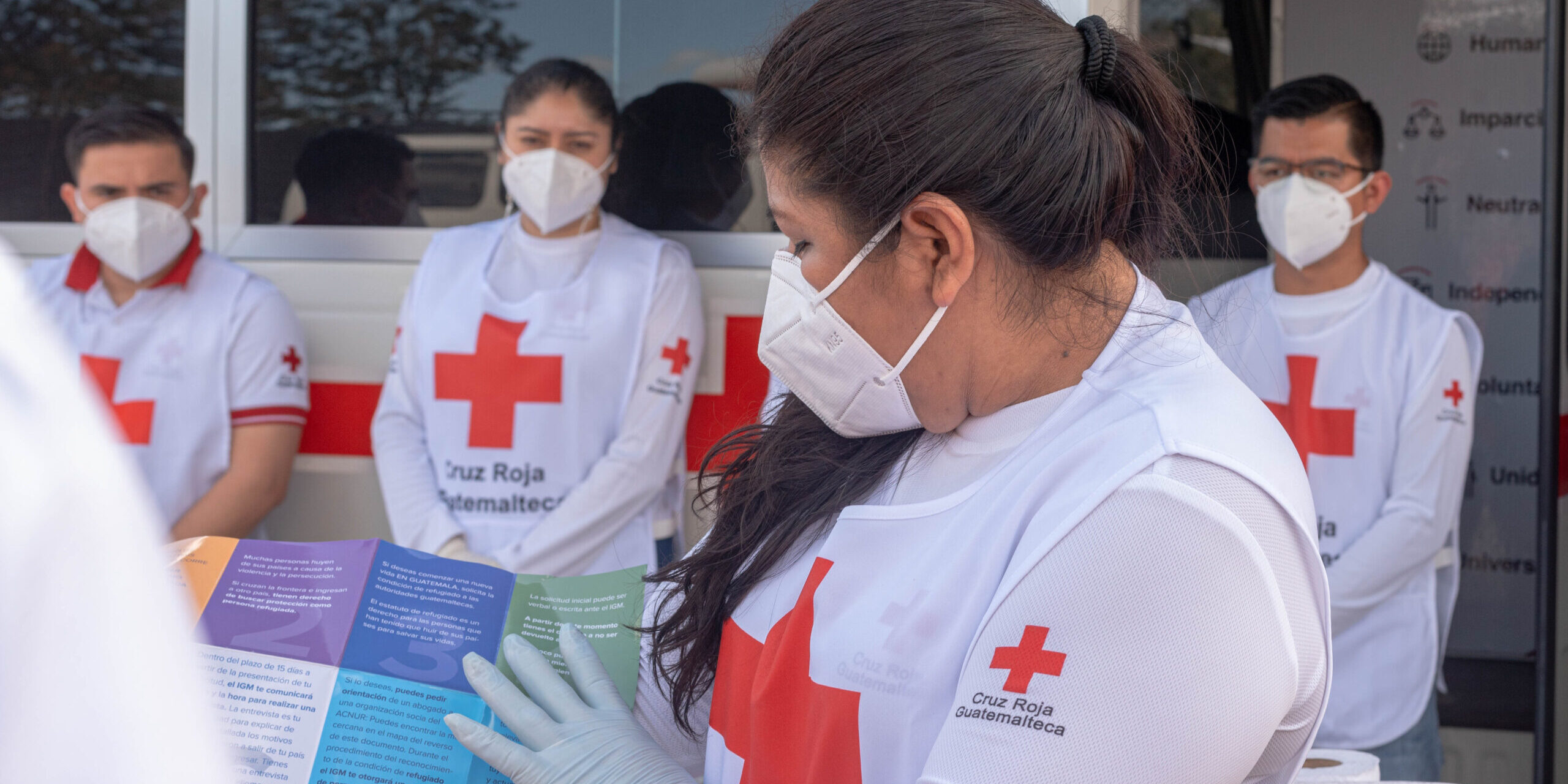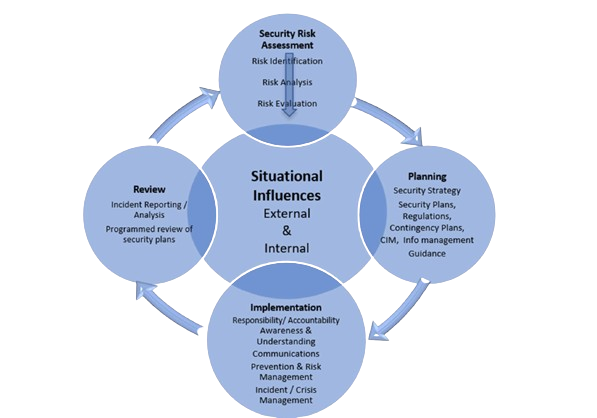Security

For more detailed information especially for volunteers and personnel working in disasters, high-risk environments, and remote locations please refer to: Personal Security Section.
Overview
Humanitarian work is not just a job. The humanitarian mandate will probably have you working in environments that are unstable, complex, unpredictable, and hence inherently dangerous. It’s always going to be a challenge – for your organization and for you – to create and develop close links with local communities, so that you can build up their resilience and provide them with protection and assistance – while staying safe.
The operational context has grown increasingly challenging: humanitarian efforts are now entangled in political complexities and frequently face threats from criminal activities. The legitimacy of humanitarian access is often doubted by certain individuals, while the proliferation of weapon bearers is on the rise, manifesting in decentralized and covert networks.
Ensuring the safety and security of Humanitarian Service points for migrants is paramount, particularly in locations frequently situated in border areas, post-conflict regions, or along dangerous migration routes. These critical points serve as lifelines for individuals navigating treacherous circumstances, offering essential support amidst displacement, violence, and health risks. By strategically placing these service points, often in proximity to areas of heightened need, we aim to address the unique challenges faced by vulnerable populations. Prioritizing safety and security measures in these locations is imperative to create environments where individuals can seek assistance without fear of harm or exploitation. Simultaneously, safeguarding the well-being of humanitarian workers is equally crucial, as they operate in challenging contexts to provide aid and cultivate stability for displaced individuals. Establishing secure conditions in such high-risk areas not only upholds the principles of compassion and assistance but also significantly contributes to the effectiveness and sustainability of humanitarian efforts. The protection of all involved parties ensures that the aid provided is delivered in an environment of trust, dignity, and respect.
Typically, we will employ the term "security" when discussing intentional actions, like attacks and crime, and use "safety" when considering threats unrelated to deliberate acts, such as road accidents, illness, and natural disasters. However, there may not always be a clear-cut distinction between the two.
things to keep in mind
Failing to comprehend your surroundings is akin to navigating unfamiliar terrain without a map, making it difficult to foresee challenges. Familiarize yourself with the culture of the country where you work, delving into its history, traditions, and various social, economic, and cultural facets. This effort will aid you in determining appropriate behavior and understanding the boundaries that should not be crossed. Additionally, it will empower you to recognize potential threats in your region and take essential precautions.

Design
Security specialists [1] are in the field to enable the organisation to: “reach, stay, and deliver while protecting staff from physical and psychological harm" (or at least reduce it to an acceptable risk level). It is essential to involve safety and security specialists from the beginning in the planning of humanitarian service points. An overlapping approach promotes collaborative thinking and solutions rather than a "siloed" response. Avoiding working in silos but with a collaborative spirit will lead to successful implementation.
To effectively navigate your work environment and setting up a properly and safe HSP, it is essential to conduct a comprehensive analysis of the contextual issues and the influential forces at play. This analysis is crucial for determining your objectives, establishing connections with communities, ensuring the safe execution of activities, and maintaining an updated understanding of the processes shaping both the humanitarian situation and your security.
As a tool for conducting a detailed analysis of the operational context, we suggest using the Security Risk Assessment (SRA). The SRA is the formal process used to identify and assess the security and safety risks in the working environment as well as the prevention and mitigation measures needed to protect personnel, assets, and operations from those risks.

What are the benefits of doing an SRA?
Steps of the SRA process:
- Context Assessment (i.e., understand the big picture).
- Identify and list the specific threats in the operational area.
- Describe each threat.
- For each threat, list the vulnerabilities and existing mitigation measures.
- Assess the likelihood and impact of each threat to the organisation (based on the above).
- Plot the threats according to their risk level (likelihood x impact) in the risk matrix.
- Identify (additional) mitigation measures that are needed (to reduce the risk if necessary)
- Complete the Security Risk Register (SRR).
The steps are explained in more detail in the following link: SRA instructions.
The landscape of humanitarian entities has expanded, displaying a wide range of aims and methodologies. Rarely is the RCRC the sole presence in a region, especially amid prominent natural disasters or humanitarian crises. While this multiplicity can prove advantageous in addressing diverse needs on a large scale, it poses challenges for the general population in distinguishing among humanitarian organizations. Non-specialists find it particularly daunting to differentiate between components of the Movement, such as the IFRC, UNHCR, and ICRC, given the strikingly similar emblems, identical vehicles, and overlapping fields of activity. Additionally, agencies with backgrounds in the private sector, religion, or the military contribute to the complexity of the aid sector. Collaborations and partnerships further contribute to confusion, as seen in UN agencies engaging in joint operations with armed forces involved in conflicts. Although collaboration is common, the coordination among humanitarian organizations often falls short, leading to significant difficulties arising from disparities in identities, visions, objectives, rules, operating principles, and affiliations.
To mitigate confusion and avoid being erroneously grouped with other humanitarian workers and organizations, it is essential to clarify distinctions and:
The reputation of other humanitarian organizations can impact your security.
Build
The obligation extends to implementing measures aimed at eliminating, avoiding, or diminishing foreseeable security risks to personnel, assets, and the organization as a whole. These mitigation measures should be grounded in a formal Security Risk Assessment, recognizing that each context presents unique security challenges. Additionally, the implementation of these measures aligns with the ongoing maintenance and utilization of the security risk register to effectively track and manage identified risks.
The primary purpose of the security plans[2] is to define the security rules for offices and field operations. They also include an overview of the risks that are present in the operational area, as well as provide some security guidelines. The IFRC recommends 6 documents for security plans, but each organization has its own standards (MSR Part 2: Risk Prevention and Mitigation)
The responsibility to formulate contingency plans[3] for responding to and overseeing security incidents is imperative. Despite efforts in risk assessments and preventive measures to minimize incidents, the inevitability of serious accidents and occurrences persists. Consequently, Senior Managers or team leader assigned to the Humanitarian Service Points must guarantee their capability to promptly communicate with and locate staff, ensuring efficient and effective management of serious incidents, even in low-risk settings:
Personnel Location and Contact Information
Senior Managers or team leader assigned to the Humanitarian Service Points must maintain an up-to-date record of all their personnel, including their names, phone numbers, and addresses (or field locations). This record must be accessible to them 24/7.
Emergency Medical Evacuation Plan and Relocation Plan
The Humanitarian Service Points must ensure that all the location where the HSP are established have an emergency medical evacuation plan and relocation plan.
Responsibility to communicate risks and establish procedures is crucial to keeping personnel informed. This guarantees that managers and other staff possess the necessary information to make well-informed decisions:
Incident reporting
Personnel in the HSP must report security incidents to their managers immediately.

Information sharing
All personnel (under HSP security management responsibility) must be informed promptly when there is a change in the security risk assessment, security regulations and contingency measures/plans. Time must be allocated in routine staff meetings allowing personnel to raise and discuss security issues.
A well-planned and transparent approach to setting up and opening a Humanitarian Service Points will mitigate many of the risks involved. The process is not linear, and every situation will have different requirements. A site security assessment is a practical crucial step before establishing HSP for several reasons. Firstly, it helps identify additional potential risks and vulnerabilities in the chosen locations not identify in Security Risk Register, allowing organizations to implement appropriate security measures to safeguard both personnel and beneficiaries. Secondly, a thorough security assessment enables organizations to tailor their security protocols to the specific challenges of the chosen sites.
[1] A "security specialist" typically refers to an individual who has specialized knowledge, expertise, and skills in a particular area of security. This could include someone who focuses on a specific aspect of security such as cybersecurity, physical security, or risk assessment. Security specialists often have in-depth training and experience in their specialized field.
[2] Security plans are comprehensive strategies outlining measures and protocols to safeguard assets, personnel, and organizations from potential threats or risks.
[3] Contingency plans are pre-established strategies designed to address and manage unforeseen events or emergencies, ensuring a prompt and effective response.
More details on the site security assessment are possible to found in: Distribution Safety — The IFRC Guide to a Safer Mission.
Explosions are a risk in some areas where we work, particularly in conflict areas. Explosions take many forms. They include aerial bombs and explosive devices placed near high-profile targets such as security forces sites and government buildings, or more public places such as political gatherings, places of worship and tourist areas.
A common tactic is to plant multiple bombs to explode on delay. The first explosion creates casualties, while the secondary targets first responders and onlookers.
In all cases, if there is one explosion, assume there will be more! Always take cover and stay away from windows!
Learn what to do HERE.
The following tips are designed to support training sessions for Red Cross Red Crescent volunteers and other humanitarian personnel who may be setting up an HSP in disaster-affected areas:
